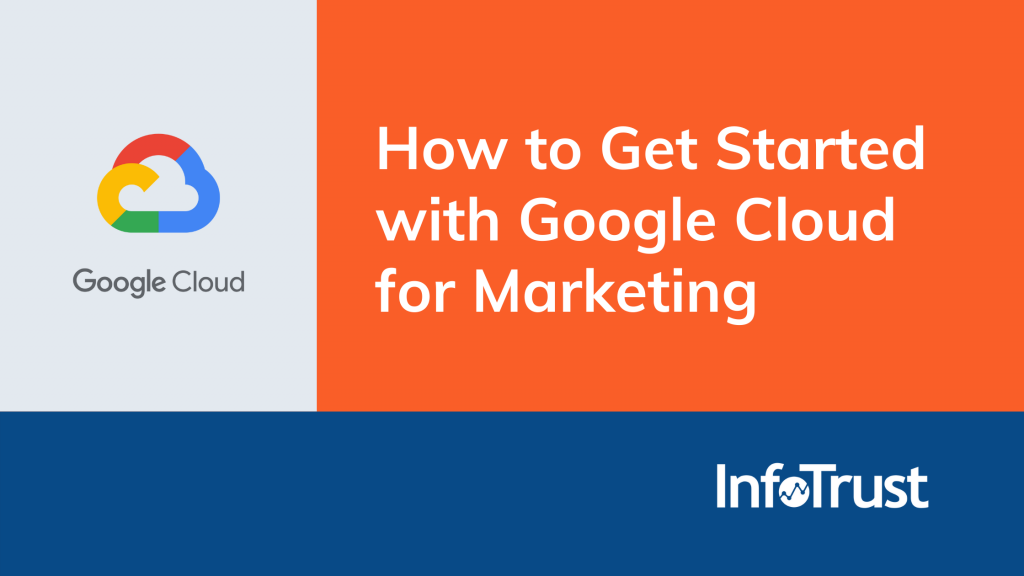Chances are, you’re no stranger to the idea of using Google Cloud. There’s a lot of conversation about cloud capabilities’ promise for improving marketing. You may have heard, “The cloud is great for helping you bring your data together,” or “It will help you get a better, more comprehensive view of your customer.” But all too often, the conversation stops there.
Even if you’re sold on the cloud’s capabilities, you might be left wondering, What does using the cloud really mean? What are these tools and how do I use them? Below, I’ll explain what the cloud can actually help you accomplish and break down the steps you and your organization need to take to get started.
The Three Major Benefits of the Cloud
A Gallup study recently showed that marketers who use customer data in marketing outperform peers by 85 percent in sales growth and more than 25 percent in gross margin. Put simply, good data use is at the heart of good marketing. And if you want to use your data well, that means you need a central place where you can access, integrate, and utilize that data. That central place is the cloud.
By unifying data in the cloud, marketers can uncover new insights about customer behavior that weren’t obvious before. You’ll see three major benefits almost instantly:
- You’ll have a clearer picture of the customer journey. Easily integrate marketing data in order to measure and better understand the various ways customers interact with your business, from ad campaigns and loyalty programs to visiting your website and app. Integrated data helps you unlock certain patterns about your customers that you didn’t recognize before.
- You’ll be able to create more personalized experiences for your customers. With the deprecation of third-party cookies, organizations may soon face challenges obtaining an extremely granular level of personalization. In this new, privacy-centric landscape, the cloud is indispensable for helping you find ways to become savvier with segmentation. Integrating your first-party data will ultimately help you create more engaging, personalized experiences that increase loyalty and drive revenue by better segmenting your customers, generating custom audiences, and tailoring content at scale.
- You’ll be better equipped for predicting marketing and business outcomes. Google Analytics is a great collection tool, but it doesn’t offer marketers a good way to predict different business outcomes, profitability data, or sales forecasts. Use Google Cloud’s powerful machine learning to get a clearer picture of how customers will engage with your business and forecast the impact of your decisions, including how you invest marketing resources.
Build a Team
When other marketers ask me how to start using cloud technology to leverage data and build more customer-oriented marketing, my first answer is, “Team up with a few data scientists, either internally or through a consulting partner.”
Every organization will have different needs, but generally, the right team will include the following people:
- Someone with the ability to understand and write queries. This may be a database engineer, a.k.a., a data wrangler.
- An engineer who understands some kind of language that is able to read and write from data APIs. This is the person who will move your data around. Typically, this person is known as an ETL engineer or integration engineer.
- A data architect who can understand how your data strategy fits together and where it needs to be going.
- A visualization expert who can make dashboards.
- A project manager to oversee the project strategy and keep the process on track.
Because marketers and engineers come from such different perspectives, it’s important to find common ground where you can articulate your needs. When you have your first meeting, start by asking these introductory questions:
- What are the top three data silos that could be combined to get a better view of our customer journey?
- What new customer insights could we unlock by combining our customer data?
- How can we connect audience insights to media activation and drive better performance?
While there are no quick answers to these questions, they can kick off discussions that will lead to entirely new ways of thinking about data-driven marketing.
Understand Your Data
Before your team gets cracking on any projects, it’s important to take an inventory of what data assets you have, where they’re stored, and how disparate or unified those assets are.
While taking inventory you will most likely find that data tends to exist all over the place. I sometimes find that organizations silo their marketing performance data, like media spend, from their analytics data. Often, offline and online transactional data are also kept separate, as are CRM and CDPs. In order to make your data actionable, you will need to centralize it in cloud data storage, such as Google BigQuery.
The world of digital marketing is loaded with data points. When entering the cloud it is important to separate the noise from the data that will bring true business value. Consider what business goals you have for your data and ask:
- How does my current data relate to my goals?
- How might my different data silos fit together? (For example, would putting your online sales data next to your brick-and-mortar data change your idea of the customer journey?)
- Where do I have holes in my data strategy, and how can I start getting the data I need?
Prioritize
No matter how motivated you are to get your cloud journey underway, no company will be able to integrate everything at the same time. Prioritization is the key to building a solid, sustainable data strategy. Before making any moves, identify a problem that you want the data to solve.
As I mentioned, the cloud is a very powerful resource for marketers, which means that you’re going to have a lot of options for data collection and analysis moving forward. Here’s my word of warning: I recommend starting with a small problem that won’t take long for you to solve. If you start with your customer lifetime value first, you’re going to have to test your new segments, and it will take six to nine months before you have any real results.
If you start with an easy problem that can be tested rapidly, you can recoup your investment right away while larger projects simmer in the background.
Validate Your Findings
Once you’ve identified a problem and have collected the data you need, it’s time to start pulling everything together. You will likely use Google Cloud’s Dataprep and Dataflow tools to build a data pipeline that brings your data together into a singular place where it becomes actionable.
Once your data is together, it would be great if you could just hit the ground running, but it’s important to make sure your results are accurate. One of the best ways to validate your data is to use visualizations to compare your findings to the source data and make sure they’re matching up correctly.
Tools like Looker will allow you to classify your data, deploy definitions for that data (e.g., what constitutes a transaction), and then allow you to quickly use those definitions to make visualizations across your whole data set.
Data Studio is another useful tool that allows you to make dashboards on top of Big Query tables, meaning that visualizations are mere minutes away. (Keep in mind that these are basic visualizations intended to test the accuracy of your results. Your organization will likely need more sophisticated visualizations down the line. Remember, what really separates quality visualization is the ability for your dashboards to tell the specific story you need for your business problems.)
Let the Fun Begin
Once your data is accurate, your team can really start playing with it. They can create their own Jupyter notebooks to begin deploying models. Or, they can use AutoML for larger, more complicated data science projects. Google also has a suite of built-in machine learning platforms that you can leverage to determine your customer lifetime value, perform sentiment analysis, or predict future market trends.
If any of those terms sound unfamiliar to you, don’t worry. Your engineering team will understand the technological nitty-gritty. What’s important is that you understand just how powerful the cloud can be for helping you solve some of your most important marketing problems.
At the end of the day, here’s what the cloud is good for: bringing together your data so you can create a more accurate, meaningful, and personal connection with your customer. If you can do that correctly, your customer relationships will improve and so will your bottom line.




